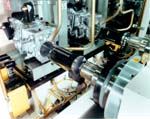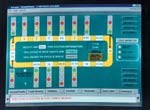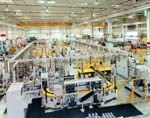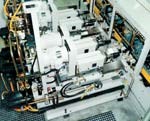Making Motors With Non-Sync Lines
Many shops use cellular manufacturing as the basis for their production capability and capacity. Briggs&Stratton used cells to make its small engines until the plant hit a production efficiency wall. The company then turned to non-synchronous transfer lines. Here's how this technology has impacted the plant.
Share



.png;maxWidth=45)
DMG MORI - Cincinnati
Featured Content
View More

ECi Software Solutions, Inc.
Featured Content
View More
Autodesk, Inc.
Featured Content
View More


Very few of us are unfamiliar with the Briggs & Stratton internal combustion engine. These workhorses power everything from lawn mowers to outboard motors. They are reliable, low maintenance and relatively inexpensive.
We visited the company's Rolla, Missouri, plant to look at how Briggs manufactures its small horsepower engines, in quantity and with quality. The plant is relatively new, and when Briggs began occupying the site in 1995, it took the opportunity to revamp how the major components of its 5.5 through 6.5 horsepower vertical and horizontal shaft motors were machined.
This revamp included a concerted effort to replace numerous manufacturing cells with non-synchronous transfer lines.
Many drivers, including increased production volumes, better quality and manufacturing cost reductions, converged to push the plant's manufacturing engineers to consider non-sync over the more familiar cellular production techniques. The net result has been more consistent quality, lower manufacturing costs and a better global competitive position for the company.
To find out more about this high volume manufacturing technology and how it fits into the volume production continuum, we also visited Michigan Machining & Engineering (Fenton, Michigan), a division of Unova's Lamb Technicon. It has put in many non-synchronous systems, including those used at Briggs.
Making Small Engines
Three major castings comprise the Briggs & Stratton small engine. They are a cylinder, a cylinder head and a sump or cover. Each of these cast aluminum components is manufactured at Rolla on its own non-synchronous transfer line.
Production for one of the Rolla Plant transfer lines is about 400 parts per hour. Each transfer line must be able to handle several model variations of each component. For example, there are nine different cylinders and two cylinder heads that must be accommodated by their respective transfer lines. The family of cylinders includes horizontal and vertical crankshaft orientations.
The first station that a raw casting reaches at each of the Rolla plant's non-sync transfer lines actually lies outside the line. It's a manual operation that prepares the various castings for the transfer line.
Here a fixture-locating surface is accurately milled, and two dowel pins are inserted to simplify loading onto the transfer line pallet. One station is used to load and unload parts to and from the line. One operator handles the job. It takes about 18 seconds total to load and unload two parts from the line. This doubling up keeps the line cycle time at 9 seconds per cycle.
It is at this manual load/unload station that an important aspect of the non-synchronous transfer line comes into play. While 18 seconds is the time specified to load and unload, because the individual pallets are not "chained" together there is some room for variation at this initial station.
The non-synchronous line can make up small cycle time differentials by dividing any lost time over all of the line's stations. This ability to rebalance itself after a minor cycle time interruption is an inherent advantage of a non-synchronous line.
Once parts are loaded into a fixture mounted on an eight-inch square pallet, it begins its journey around the transfer line. It's really not a line but a rectangle. Lamb's transfer system uses a dual flat top chain to move the pallets from machining station to station.
On the cylinder line, 92 pallets are in circulation around the non-sync line. Many different operations are performed as the pallet, fixture and part wind their way past various drilling, tapping, milling and boring stations.
Cycle time for the line is 9 seconds. To accommodate machining operations that take longer than 9 seconds, redundant stations are ganged together.
An example of this is the cylinder boring operation. At more than 30 seconds, this operation has the longest cycle time on the cylinder-making transfer line.
To keep the overall cycle time at the targeted 9 seconds, this station uses four duplicate boring heads. These allow the boring operation a window of 36 seconds of available cycle time. The non-sync transfer chain allows four pallets to accumulate at this boring station, which then proceeds to process them simultaneously. So while the total operation takes 36 seconds, dividing it by four gives a net of 9 seconds and keeps the line on target.
When the four pallets are released from the boring station, they move to the next operation and queue up there. Non-synchronous transfer allows this to occur because the transfer chain moves under the pallets and is only connected to them by gravity.
A pallet can be held at a machining station while the transfer chain continues to move under it. Once the pallet is released, it moves with the chain to the next machining station. This cycle of machine-then-transfer-then-machine continues around the rectangle until the workpiece is unloaded at its original load/unload station.
Keeping Track
An advantage of the non-synchronous transfer line for Briggs is that in-line gaging stations can be used. As long as the gaging operation is less than the machine cycle time, these gaging operations have no impact on the line's production rate.
Strategic placement of the gaging stations alerts the line operators to any variance in tolerance from worn tools or other sources. "Once a problem is detected, we can comp or change out a tool within a couple of cycles," says Mark Puzach, Briggs' manager—aluminum machining. "In most cases, we can simply run the affected workpiece back through the transfer line and avoid scrapping it."
A control station, located near at the load/unload station, allows monitoring of all machining stations. It also allows the line operators to set and keep track of tooling life cycles. "Our goal with tooling," says Mr. Puzach, "is to replace a tool before it breaks. Even if there is some life left in the tool, it's in our best interest to err on the side of caution when it comes to keeping the line running. We can re-sharpen a dull tool, but a broken tool is scrapped."
Pre-set tooling, done off-line, is a key to efficient operation and quick changeover of a cutter. Pre-set redundant tools are available at various locations around the line for easy access.
Because Briggs makes a family of parts on its non-sync transfer lines, changeover from one component to the next is all part of a day's work. "Depending on production needs, we may change over the line two or three times in a day," says Mr. Puzach. "It generally takes about a half hour to change over and set up for a different component. Pre-set tooling makes this job much more efficient."
Accuracy Where It's Needed
On Lamb's non-sync line, the transfer mechanism is not critical to the location of a workpiece as it is machined. Instead, the chain carrier is a relatively simple device that is designed simply to convey a pallet from one station to the next.
The critical locating point is within the machining station itself. Lamb uses a two pin locking mechanism that secures the pallet in all directions. "We only need an accurate location where a tool contacts the work," says Ibrahim El Assar, product sales manager for Michigan Machine & Engineering. "It's more economic for the shop to have the transfer system to be as simple as possible and put the cost of accurate pallet location where it's needed—at the machining station."
The machining stations used by Briggs are located around the periphery of the non-sync rectangle. They can be on either side of the transfer chain and allow easy access for maintenance and changeover. Most are single axis feed using box ways and either hydraulic or ball screw actuation. Stroke settings are programmable.
An advantage of the non-synchronous transfer mechanism is that it can be expanded with relative ease. "Depending on what the plant sees as its future production needs," says Mr. El Assar, "the line can be built to accommodate additional stations by making additional space around the transfer line, or the line itself can be expanded using modular segments. Either way, it's generally less expensive to modify a non-synchronous line than a synchronous one."
As an example, Briggs' first non-synchronous cell was installed in 1980 and is still used today. Since it was installed, the line has been completely re-purposed three times to accommodate changes in product.
The essential transfer line component has remained the same. Only new machining stations have been added and/or deleted to manufacture the new engine components that have come along in the 20 years.
The Way They Were
From stand-alone mills making prototypes to dedicated transfer lines cranking a million or more automotive components per year, shops look for the appropriate level of technology to do the job. The efficiency goal is to hit the sweet spot of productivity without going over or under capacity. It's about finding the right level of technology to produce the quantity and quality needed for the application without wasted resources.
Briggs' Rolla plant is a good representative of the higher volume production dilemma faced in many other plants. Its family of small engine components is made in significant enough volumes for its plant and other Briggs facilities to allow it to apply transfer line technology with good efficiency. With the non-synchronous transfer line, Briggs has struck a balance between sufficient machining flexibility, to make a family of parts, and machining efficiently, to accomplish the production bogey. But it wasn't always so.
According to Mr. Puzach, "before the non-sync transfer lines went in, production was carried out on cells comprised of 13 machining centers." Each machine had an operator, and there were load/unload people between the machining stations," says Mr. Puzach. "Labor costs were high in these cells, and more important, the amount of manual material handling had an impact on quality. Parts might be loaded incorrectly at a number of points, any one of which would scrap out the workpiece."
To accomplish the small engine plant's production quotas, five of these 13 machine cells were used to produce the major engine components for the Briggs motors. Production per cell was significantly below the output of non-synchronous transfer lines and had three times the labor costs. The cells had high flexibility but labor costs and process control issues forced Briggs to evaluate how it was making parts.
These cells lacked much of the in-process gaging capability that is found on the transfer line. "Our scrap rates have been halved with the non-sync lines," says Mr. Puzach. "Much of that improvement has been because of reduced handling of the workpieces and the ability to catch machining errors before they can stack up to scrap a component."
The Rolla plant, along with several other Briggs manufacturing facilities, has standardized production using non-sync lines. Standardizing on non-sync transfer lines allows the company to strategically shift production from plant to plant as market conditions change. Training and tooling issues are minor due to the standardization of process and equipment.
Who Needs Non-Sync?
At the high end of the production volume spectrum are lots and lots of the same workpieces. Here, one finds hard automation in the form of transfer lines that are built to machine the one million or more transmission cases or other parts that will be needed in a given year. The manufacturing system is made to make that part and pretty much only that part. It's inflexible but very efficient.
So the question boils down to what technology is best for a given application based on its tolerances, variability, volume requirements and cost? Obviously, there are numerous production plateaus that can be achieved with a given manufacturing system, be it stand alone machines, cells or transfer lines.
Drilling down a bit further, cycle time also plays a critical role in production planning. How many good parts can be made in a given amount of time is the coin of the realm for high volume manufacturing. Moreover, product mix plays an important role in any decision about how much flexibility to have versus production efficiency.
Non-synchronous transfer line technology seems to represent a different approach to the production environment. Its production capacity falls at the same level or higher than dedicated hard automation and significantly above the typical capability of manufacturing cells. As we've seen with Briggs, non-sync also offers enough flexibility to accommodate families of parts but maintains the ability to hit high production volumes.
Read Next
5 Rules of Thumb for Buying CNC Machine Tools
Use these tips to carefully plan your machine tool purchases and to avoid regretting your decision later.
Read MoreBuilding Out a Foundation for Student Machinists
Autodesk and Haas have teamed up to produce an introductory course for students that covers the basics of CAD, CAM and CNC while providing them with a portfolio part.
Read MoreRegistration Now Open for the Precision Machining Technology Show (PMTS) 2025
The precision machining industry’s premier event returns to Cleveland, OH, April 1-3.
Read More



.png;maxWidth=150)































.jpg;maxWidth=300;quality=90)





.jpg;maxWidth=300;quality=90)











